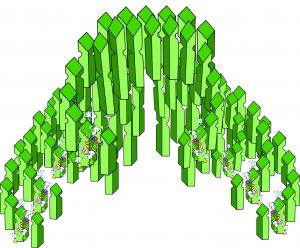Tomatoes are possibly one of the easiest things to grow and display a huge range of sizes – from tiny cherry varieties to much larger beefcake ones. They provide our salad ingredients, the base for many of our sauces and of course, tomato ketchup. But did you know that cultivated tomatoes can reach sizes up to 1,000 larger than their wild cousins?
Since known by a variety of nicknames, tomatoes originated in South America and were cultivated approximately 10,000 years ago. Cultivation involved breeding plants that produced the most desirable fruit with each other (crossing). As with any process involving duplication of DNA, the Dinky Amigos were busy dancing their way to a bigger and better fruit.
But not all of the Dinky Amigos were happy. There was a mutiny going on in an area now called the Cell Size Regulator (CSR) gene. It was during this period of crossing – and dancing – that some of them (1,406 to be precise) had had enough. 
They left and disappeared from the gene (deletion). This exodus was desertion on a massive scale – two thirds of the original Dinky Amigos line-up absconded in a short period of time. As we know, the Dinky Amigos generate the instructions for the cell. This left the remaining Dinkies to take on the task of controlling cell size by themselves.
Normally such a slashing of Dinky Amigo numbers in a gene would have devastating consequences for the cell. But not this time.
They danced their socks off and managed to keep their village safe and the cell growing.  They even managed to create more villages (endoreduplication). As expected, however, they couldn’t quite complete the entire task all by themselves. They became a bit more relaxed about how many villages they were creating. They made more than they had before. Quite a lot more. (For comparison, the village count in humans is two. In modern tomatoes it may be 8, 16, 32 or even as many as 512).
They even managed to create more villages (endoreduplication). As expected, however, they couldn’t quite complete the entire task all by themselves. They became a bit more relaxed about how many villages they were creating. They made more than they had before. Quite a lot more. (For comparison, the village count in humans is two. In modern tomatoes it may be 8, 16, 32 or even as many as 512).
The cell thrived on this kind of attention and grew bigger to accommodate the many villages springing up. The fashion for large cells was here! Other tomatoes jettisoned their larger CSR genes to take on the new, slimline version. They swelled their cells to make way for the new villages. Dancing on a grand scale was here!
It wasn’t just the tomatoes that were happy. The Dinkies’ hard work resulted in a larger, fleshier area just under the skin known as the pericarp. This just so happens to be the part which humans enjoy the most. Now an understanding of what causes the diverse range of sizes in our tomatoes can potentially be developed further.
After thousands of years where the tomato has gone from food, to decoration, to food again, this particular gene is now under scrutiny. Larger cells lead to heavier fruits and greater profits for farmers. If fruit size can be increased in tomatoes, it can possibly be increased for relatives of the tomato such as potatoes, aubergines and peppers. If that can be done, there may be possibilities for other fruit. As the world looks to food security as one of its top priorities, this discovery may be able to contribute to the solution.
